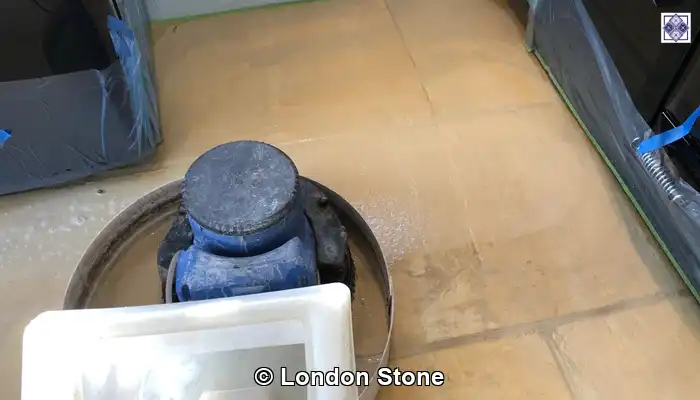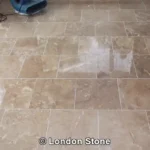Key Points Summary: “Limestone Floor Restoration Services: A Comprehensive Guide”
-
- Limestone is a porous, acid-sensitive stone that requires specialist care to maintain its appearance and durability.
- Common issues include dullness, etching, staining, grout erosion, and lippage, which are often caused by foot traffic, spills, and improper cleaning.
- DIY cleaning methods can exacerbate damage, especially when using acidic or abrasive products that are not suited for limestone.
- Professional restoration involves inspection, deep cleaning, diamond honing, regrouting, and sealing: tailored to the stone’s condition and location.
- Sealants must be breathable and UV-stable; chosen based on room use (e.g. kitchens, bathrooms, heritage interiors).
- Case studies from London homes show successful transformations in kitchens, hallways, and bathrooms using expert techniques.
- Post-restoration care includes pH-neutral cleaning, sealant top-ups, and avoiding steam or harsh chemicals to preserve the finish.
- London Stone serves Central, North, South, East, and Greater London, including heritage properties and commercial sites.
Why Limestone Needs Specialist Restoration
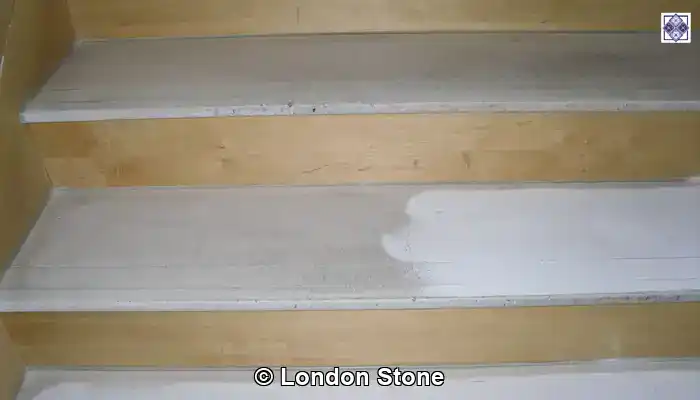
Limestone Floor Restoration Services Explained Simply: Limestone flooring brings a timeless elegance to homes and commercial spaces across London. Its soft, natural tones and subtle veining make it a popular choice for hallways, kitchens, bathrooms, and even heritage properties. But while limestone is undeniably beautiful, it’s also one of the more delicate natural stones—and that means it requires specialist care to maintain its appearance and integrity over time.
Pro Tip: We recommend these products for daily Limestone maintenance cleaning.

Fila Pro Floor Cleaner
|

LTP Floorshine
|

Vileda H2PrO Spin Mop System
|
Understanding Limestone as a Natural Stone Surface
Unlike granite or porcelain, limestone is a sedimentary stone formed from compressed marine materials over millions of years. Its composition makes it relatively porous and sensitive to acidic substances, which means it can easily absorb moisture, cleaning chemicals, and spills. This vulnerability leads to common issues like staining, etching, and surface erosion—especially in high-traffic areas or rooms exposed to frequent cleaning.
Common Limestone Floor Problems in London Homes
Homeowners often notice their limestone floors losing their natural sheen, developing uneven patches, or showing signs of pitting and grout damage. These issues aren’t just cosmetic. When sealants break down or grout begins to erode, moisture can seep into the stone and the subfloor, leading to more severe structural problems. In heritage buildings, this can compromise original flooring and lead to costly repairs.
Why DIY Stone Cleaning Often Makes Things Worse
Generic stone cleaners and off-the-shelf sealants may seem convenient, but they’re rarely suitable for limestone. Acidic or alkaline products can etch the surface, leaving dull spots or streaks. Improper sealing can trap moisture or fail to bond with the stone’s porous structure. Without the right tools and expertise, DIY attempts often cause more harm than good—especially when dealing with delicate finishes or uneven tile layouts.
The Role of Professional Stone Restoration Services
Professional limestone restoration goes far beyond surface cleaning. It begins with a detailed inspection to identify the root causes of damage—whether it’s improper sealing, acidic spills, or wear from foot traffic. Restoration specialists use pH-neutral cleaning solutions that lift ingrained dirt without harming the stone, followed by diamond honing to smooth out scratches and restore a consistent finish. Grout lines are repaired or replaced, and breathable, UV-stable sealants are applied to protect the stone from future damage.
Protecting Heritage Flooring with Expert Care
Whether your limestone floor is in a modern townhouse or a listed property, restoration is an investment in both beauty and durability. With the proper care, limestone can last for decades—offering a warm, natural surface that enhances any space. But it takes more than a mop and bucket to keep it that way. Specialist restoration ensures your floor not only looks its best but performs its best, year after year.
Understanding Limestone Flooring
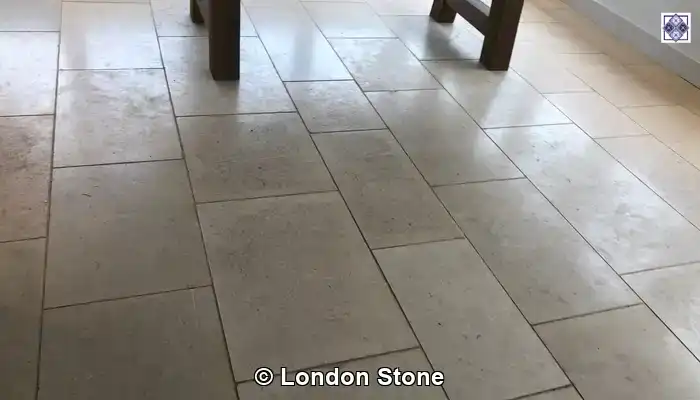
Limestone is one of the most widely used natural stones in UK homes, prized for its warm tones, subtle textures, and ability to complement both modern and traditional interiors. But beneath its elegant surface lies a material that’s surprisingly sensitive—and that sensitivity is exactly why restoration must be handled with care.
What Is Limestone? A Sedimentary Stone with Character
Limestone is a sedimentary rock formed over millions of years from compacted marine organisms and minerals. Its composition includes calcium carbonate, which gives it a soft, chalky texture and a natural porosity. This porosity is what makes limestone so receptive to polishing and sealing—but also what makes it vulnerable to staining, etching, and moisture damage.
Unlike granite or quartzite, limestone is not resistant to acid. Even mild acidic substances, such as lemon juice, vinegar, or some household cleaners, can react with the surface, causing dull spots known as etching. This is especially common in kitchens and bathrooms, where spills and cleaning routines are frequent.
Why Limestone Needs Tailored Restoration Techniques
Because of its softness and absorbency, limestone cannot be treated like harder stones. Restoration requires a careful balance of cleaning, honing, and sealing—each step tailored to the stone’s condition and environment. For example, a hallway floor exposed to muddy boots and foot traffic will need deeper cleaning and a more durable sealant than a lightly used guest bathroom.
Professional restoration begins with identifying the stone’s finish—whether it’s honed, polished, or tumbled—and assessing the level of wear. From there, specialists use pH-neutral cleaners to lift embedded dirt without damaging the surface, followed by diamond abrasives to smooth out scratches and restore uniformity. The final step is sealing, which protects the stone from future damage while allowing it to breathe.
Limestone vs Other Natural Stones: Why It’s Unique
Compared to marble, limestone is less dense and more prone to surface erosion. Compared to travertine, it has a finer grain and fewer natural voids, but still requires regular sealing to maintain its appearance. These differences mean that restoration techniques must be adapted—not just copied from one stone type to another.
Homeowners often assume that all stone floors can be treated uniformly. But using a marble polish on limestone, or applying a generic sealant, can lead to streaking, residue buildup, or even long-term damage. That’s why working with a specialist who understands limestone’s unique properties is essential.
Signs Your Limestone Floor Needs Restoration
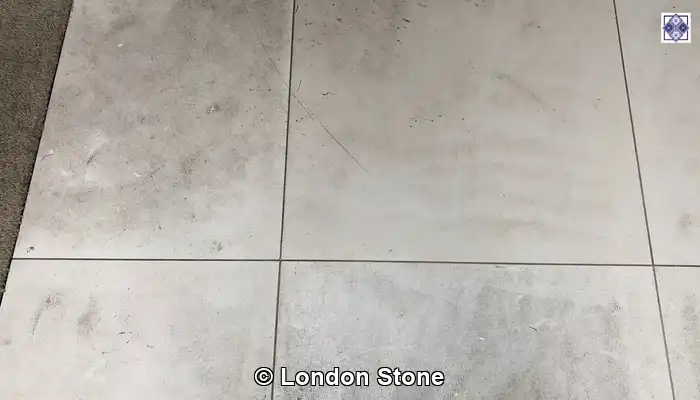
Limestone may be durable, but it’s far from immune to wear and tear—especially in busy London homes where foot traffic, spills, and cleaning routines take their toll. Recognising the early signs of damage is key to preventing long-term deterioration and costly repairs.
Surface Dullness and Loss of Shine
One of the first indicators that your limestone floor needs attention is a noticeable loss of its natural sheen. Over time, micro-abrasions from dirt, shoes, and cleaning tools can wear down the surface, leaving it looking flat and lifeless. This dullness is especially common in hallways, kitchens, and other high-use areas.
Professional polishing can restore the original finish, but it’s essential to act before deeper damage sets in. If the floor no longer reflects light evenly or feels rough to the touch, it’s time to consider restoration.
Etching and Staining from Everyday Use
Limestone’s calcium-rich composition makes it highly sensitive to acids. Even mild substances like lemon juice, wine, or vinegar can cause etching—those pale, chalky marks that seem to appear out of nowhere. Similarly, spills that aren’t cleaned promptly can seep into the stone, leaving behind stubborn stains.
These blemishes aren’t just surface-level. They often indicate that the sealant has worn away, exposing the stone to further damage. Restoration involves not only cleaning and polishing, but also reapplying a protective sealant that’s suited to the room’s specific conditions.
Grout Erosion and Discolouration
Grout lines play a crucial role in the stability and appearance of your limestone floor. When grout begins to crack, crumble, or discolour, it can allow moisture to penetrate beneath the tiles—weakening adhesion and encouraging mould growth.
In older installations, grout may have been applied too shallowly or with the wrong composition. Restoration includes removing compromised grout and replacing it with a colour-matched, durable blend that complements the stone and seals the joints effectively.
Uneven Tiles and Lippage
Lippage refers to the height difference between adjacent tiles, and it’s more than just a visual flaw—it can be a tripping hazard. Over time, subfloor movement or poor installation can cause tiles to shift, creating sharp edges or uneven surfaces.
Professional restoration addresses lippage through careful grinding and levelling, ensuring a smooth, safe walking surface. This is especially important in homes with children, elderly residents, or areas where bare feet are standard, such as bathrooms.
Embedded Dirt That Resists Cleaning
If your limestone floor still appears dirty after mopping, the problem may be more than just surface grime. Porous stone and worn sealants allow dirt to settle into microscopic pits and grout lines, making it nearly impossible to clean with standard methods.
Specialist restoration uses pH-neutral cleaners and mechanical agitation to lift embedded soils without damaging the stone. The result is a visibly cleaner, healthier floor that’s easier to maintain going forward.
Our Professional Limestone Restoration Process
Restoring a limestone floor isn’t just about making it look good—it’s about preserving the stone’s integrity and ensuring it performs well in the long term. At London Stone, our restoration process is designed to address both surface-level issues and deeper structural concerns, using specialist tools and techniques tailored to each floor’s condition.
Initial Inspection and Stone Assessment
Every restoration begins with a thorough inspection. We assess the type of limestone, its finish (honed, polished, tumbled), and the extent of wear or damage. This includes checking for etching, staining, lippage, grout erosion, and sealant breakdown. Understanding the stone’s history and environment—whether it’s a busy hallway, a damp bathroom, or a heritage-listed space—helps us determine the best approach.
Deep Cleaning with Cleaningal Solutions
Limestone’s porous surface traps dirt and cleaning residues over time, especially when sealants have worn away. We use pH-neutral cleaners specifically formulated for natural stone to lift embedded soils without damaging the surface. Mechanical agitation tools help dislodge grime from grout lines and microscopic pits, restoring a clean, uniform base for further treatment.
Diamond Honing and Surface Refinement
Once the floor is clean, we begin the honing process using diamond abrasives. This step smooths out scratches, etching, and uneven patches, restoring the stone’s natural texture and preparing it for polishing. Depending on the desired finish—matte, satin, or high-gloss—we adjust the grit level and technique to achieve consistent results across the entire surface.
Grout Repair and Regrouting
Damaged or discoloured grout is removed using precision tools that protect the surrounding stone. We then apply a colour-matched grout blend that complements the limestone and seals the joints effectively. In high-traffic areas, we may recommend epoxy grout for added durability and stain resistance.
Sealant Selection and Application
The final step is sealing. We use breathable, UV-stable sealants that protect the stone from moisture, staining, and surface erosion while allowing it to release trapped vapours. Sealants are chosen based on the room’s conditions—kitchens may require oil-resistant formulas, while sunlit areas benefit from UV protection. Application is done evenly and professionally to ensure complete coverage without streaks or residue.
Final Inspection and Maintenance Advice
After restoration, we conduct a final walkthrough with the client to ensure satisfaction and provide tailored maintenance advice. This includes recommendations for daily cleaning, seal cleaning, and periodic inspections to keep the floor looking its best.
Why Choose London Stone for Limestone Restoration
When it comes to restoring limestone floors, experience and precision matter. At London Stone, we combine specialist knowledge with hands-on expertise to deliver results that go beyond surface-level improvements. Our approach is tailored, transparent, and built on years of working with natural stone in homes, heritage buildings, and commercial spaces across London.
Proven Expertise in Natural Stone Restoration
Limestone is not a one-size-fits-all material. Its porosity, mineral composition, and finish vary widely depending on origin and installation. Our team understands these nuances and applies restoration techniques tailored to each floor’s specific needs. From diamond honing to epoxy regrouting, every step is executed with precision and care.
We’ve restored limestone floors in Georgian townhouses, modern lofts, and listed buildings—each with its own challenges. Our portfolio encompasses work on high-end interiors, underfloor heating systems, and intricate tile layouts, providing us with the depth of experience to handle even the most demanding projects.
Specialist Tools and Stone-Safe Products
We use professional-grade equipment and stone-safe products that are not available in DIY kits or general cleaning services. Our pH-neutral cleaners, breathable sealants, and dust-free grinding systems are selected to protect your limestone while delivering a flawless finish.
Whether your floor needs a satin sheen or a high-gloss polish, we match the treatment to your aesthetic preferences and the stone’s condition. We also offer sealants with UV protection, oil resistance, and anti-slip properties—ideal for kitchens, bathrooms, and sunlit areas.
Transparent Service and Tailored Solutions
At London Stone, we believe in clear communication and honest pricing. Every restoration begins with a detailed consultation and a written quote that outlines the scope of work and expected outcomes. We never upsell unnecessary treatments or cut corners on quality.
Our services are tailored to your space, usage patterns, and long-term goals. Whether you need a one-time restoration or ongoing maintenance, we’ll build a plan that fits your needs and budget.
Trusted by Homeowners and Property Managers Across London
Our reputation is built on trust, craftsmanship, and results. Clients consistently praise our professionalism, attention to detail, and ability to revive even the most neglected limestone floors. We’re proud to be a go-to resource for homeowners, interior designers, and property managers seeking expert stone care.
Case Studies from London Homes
Seeing the transformation of a limestone floor firsthand is often what convinces homeowners to invest in professional restoration. At London Stone, we’ve worked on a wide range of properties—from modern flats to heritage-listed buildings—each with its own challenges and character. These case studies highlight how tailored restoration can revive even the most neglected stone surfaces.
Restoring a Stained Kitchen Floor in Notting Hill
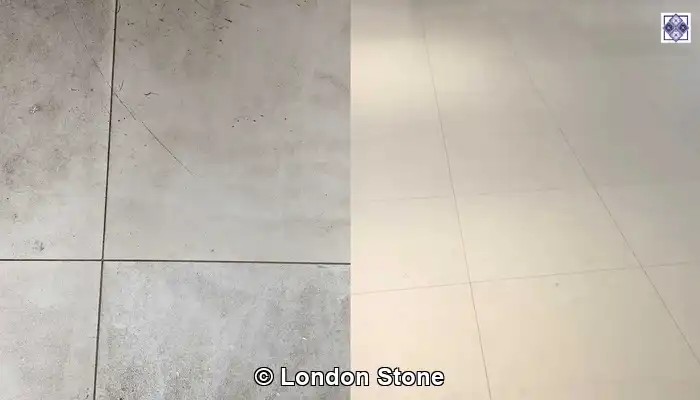
A client in Notting Hill contacted us after years of cooking spills and foot traffic had left their limestone kitchen floor dull, stained, and uneven. The original sealant had worn away, allowing oils and acidic substances to penetrate the stone. Grout lines were discoloured, and several tiles had developed surface etching.
We began with a deep clean using pH-neutral solutions to lift embedded grease and grime. Diamond honing removed the etched areas and restored a smooth, consistent finish. We then regrouted with a colour-matched blend and applied a breathable, oil-resistant sealant suited for kitchen use. The result was a brighter, more hygienic floor that looked as good as new—and was far easier to maintain.
Levelling and Regrouting in a Victorian Townhouse
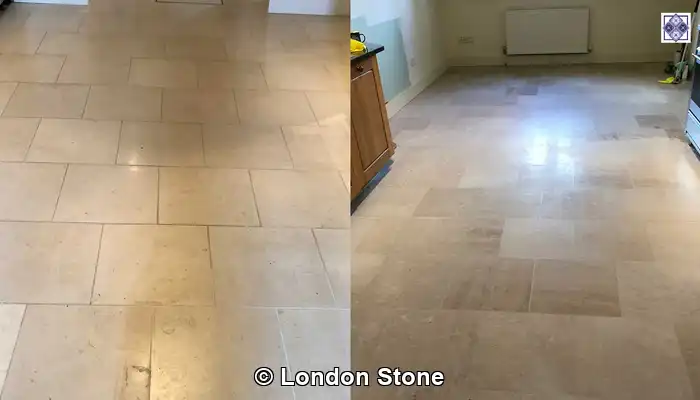
In a Victorian townhouse in Kensington, the limestone kitchen had developed severe lippage due to subfloor movement over time. The uneven tiles were not only unsightly but also posed a tripping hazard. Grout had eroded in several places, and the surface had lost its original polish.
Our team used precision grinding tools to level the tiles and eliminate sharp transitions. We removed the old grout and replaced it with a durable epoxy blend, flush with the tile surface for a seamless look. After polishing and sealing, the kitchen was transformed into a safe, elegant entryway that honoured the home’s period features.
Reviving a Kitchen Floor in a Heritage Property
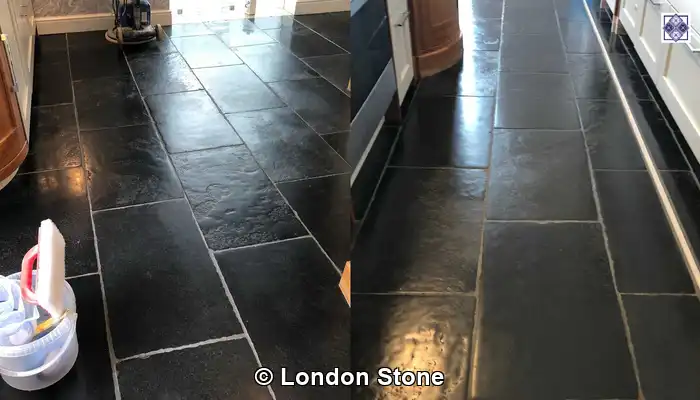
A heritage-listed property in Hampstead presented a unique challenge: a limestone bathroom floor that had been improperly sealed, leading to moisture ingress and mould growth in the grout. The client was concerned about preserving the original stone while ensuring the space remained safe and functional.
We carefully removed the failing sealant and treated the stone with a mould-safe, pH-balanced cleaner. After regrouting and polishing, we applied a breathable sealant designed for damp environments. The floor retained its historic charm while gaining modern protection against moisture and wear.
These case studies reflect our commitment to craftsmanship, safety, and tailored solutions. Whether it’s a busy family kitchen or a listed building with delicate stonework, London Stone delivers restoration that respects both the material and the people who live with it.
Maintenance Tips After Limestone Restoration
Professional restoration can dramatically improve the look and longevity of your limestone floor—but keeping it that way requires consistent, informed care. With the proper daily habits and periodic upkeep, homeowners can protect their investment and enjoy a beautifully maintained surface for years to come.
Daily Cleaning with Cleaning Products
Limestone is sensitive to acidic and alkaline substances, so it’s essential to use a pH-neutral cleaner designed specifically for natural stone. Avoid supermarket floor cleaners, bleach, vinegar, or citrus-based products, which can etch the surface and degrade sealants.
For best results, use a microfibre flat mop or spin mop dampened—not soaked—with your chosen cleaner. Excess water can seep into grout lines and beneath tiles, especially if sealants have begun to wear. Damp cleaning lifts the grime without saturating the stone.
Avoiding Common Cleaning Mistakes
Steam cleaners, abrasive pads, and harsh chemicals may seem practical, but they can cause long-term damage to limestone. Steam can weaken grout and force moisture into the stone, while abrasives scratch the surface and dull the finish.
Instead, opt for soft tools and gentle techniques. If you’re unsure about a product, test it on a small, inconspicuous area or consult your restoration specialist for guidance.
Topping Up Sealant in High-Wear Areas
Even the best sealants wear down over time—especially in kitchens, hallways, and bathrooms. To maintain protection against stains and moisture, consider topping up your sealant every 12–18 months in these zones. A breathable, UV-stable sealant matched to your stone type and room conditions will offer the best results.
If you notice water no longer beads on the surface or stains are becoming harder to remove, it’s likely time for resealing.
Grout Maintenance and Spot Repairs
Grout lines are often the first to show wear. Keep an eye out for cracking, discolouration, or gaps between tiles. These can allow moisture ingress and lead to tile movement or mould growth.
Spot repairs can be done using colour-matched grout or epoxy blends, but deeper erosion may require professional regrouting. Regular inspection helps catch issues early before they escalate.
Scheduling Periodic Professional Inspections
Even with diligent care, limestone floors benefit from periodic professional check-ups. A restoration specialist can assess the condition of your sealant, grout, and surface finish, and recommend touch-ups or preventative treatments.
For busy households or heritage properties, an annual inspection ensures your floor remains safe, beautiful, and structurally sound.
FAQs About Limestone Floor Restoration
Choosing to restore your limestone floor is a wise investment—but it’s natural to have questions before getting started. Below are answers to some of the most frequently asked queries we receive from homeowners across London.
How long does limestone restoration take?
The duration depends on the size of the area, the level of damage, and the specific treatments required. A typical residential room may take 1–2 days, while larger or more complex projects—such as heritage properties or floors with severe lippage—may require additional time. We always provide a clear timeline during your initial consultation.
Is limestone restoration safe for heritage properties?
Yes. Our techniques are designed to be non-invasive and conservation-friendly, making them suitable for listed buildings and historic interiors. We use dust-free equipment, breathable sealants, and gentle cleaning agents that preserve the stone’s integrity while enhancing its appearance.
Can deep etching or scratches be removed?
In most cases, yes. Diamond honing is highly effective at removing surface-level etching, scratches, and dull patches. For more severe damage, we determine whether grinding or tile replacement is necessary. Our goal is always to restore the stone while retaining as much of the original material as possible.
What’s the difference between polishing and sealing?
Polishing enhances the stone’s appearance by smoothing the surface and restoring its natural sheen. Sealing, on the other hand, protects the stone from moisture, staining, and erosion. Both are essential steps in a complete restoration and are tailored to the stone’s finish and room conditions.
Will the restoration process create dust or mess?
No. We use dust-controlled equipment and protective barriers to keep your home clean throughout the process. Floors are vacuumed and wiped down after each stage, and we take care to minimise disruption to your daily routine.
How often should limestone be resealed?
We recommend resealing every 12–18 months in high-traffic or moisture-prone areas, such as kitchens, hallways, and bathrooms. Low-traffic zones may require less frequent attention. During restoration, we’ll advise on the best sealant and maintenance schedule for your specific floor.
Can I walk on the floor immediately after restoration?
In most cases, you can walk on the floor within 4–6 hours after sealing, though we advise waiting 24 hours before placing furniture or rugs. We’ll provide clear aftercare instructions to ensure the sealant cures properly and the finish remains intact.
Service Areas Covered Across London
At London Stone, we proudly offer professional limestone floor restoration services throughout Greater London and surrounding boroughs. Whether you're in a city flat, a suburban townhouse, or a heritage-listed property, our team is equipped to deliver expert care wherever it's needed.
Central London and Historic Districts
We frequently work in Central London neighbourhoods such as Kensington, Chelsea, Westminster, and Mayfair—areas known for their elegant limestone interiors and period architecture. Our restoration techniques are tailored to meet the conservation standards required in listed buildings and historic homes.
North and West London Homes
From Hampstead and Highgate to Ealing and Chiswick, we serve a wide range of residential clients in North and West London. These areas often feature limestone in hallways, kitchens, and bathrooms, where foot traffic and moisture exposure demand specialist attention.
South and East London Properties
We also restore limestone floors in South London boroughs like Clapham, Dulwich, and Wimbledon, as well as East London locations including Hackney, Shoreditch, and Canary Wharf. Whether it’s a modern loft or a Victorian terrace, our team adapts restoration methods to suit the property’s age, layout, and usage.
Greater London and Surrounding Counties
In addition to London postcodes, we extend our services to nearby counties such as Surrey, Hertfordshire, and Essex. Clients in commuter towns and countryside homes benefit from the same high standards of care, with flexible scheduling and tailored service plans.
Commercial and Heritage Sites
Beyond residential work, we also support commercial clients and heritage institutions. Our portfolio encompasses boutique hotels, galleries, retail spaces, and historic buildings, where limestone flooring plays a pivotal role in the interior design. We understand the need for minimal disruption and long-lasting results in these environments.
Whether you're restoring a single room or an entire property, London Stone offers reliable, local expertise backed by years of hands-on experience.
Book Your Limestone Floor Restoration Today
Your limestone floor deserves expert care—and London Stone is here to deliver it. Whether you're dealing with dullness, staining, grout erosion, or uneven tiles, our specialist restoration services are designed to revive your floor’s natural beauty and protect it for years to come.
Schedule a Free Consultation
We offer no-obligation consultations across London and the surrounding areas. During your visit, we’ll assess your floor’s condition, explain the restoration options available, and provide a transparent quote tailored to your space and needs. You’ll get expert advice, honest recommendations, and a clear plan of action.
To get started, use our simple contact form or call our team directly. We’re happy to answer any questions and arrange a convenient time to visit your property.
Trusted by London Homeowners and Property Managers
London Stone has earned a reputation for precision, professionalism, and long-lasting results. Our clients include homeowners, interior designers, estate managers, and heritage property custodians who rely on us to restore and maintain their natural stone surfaces.
We treat every project with care—whether it’s a single bathroom floor or an entire townhouse. Our goal is to make your limestone look and feel its best, while ensuring it stays protected against future wear.
Stay Connected for Stone Care Tips
Want to keep your limestone floor looking flawless between restorations? Subscribe to our newsletter for expert maintenance advice, seasonal care tips, and exclusive offers. You can also follow us on social media for real-time updates and behind-the-scenes restoration stories.
